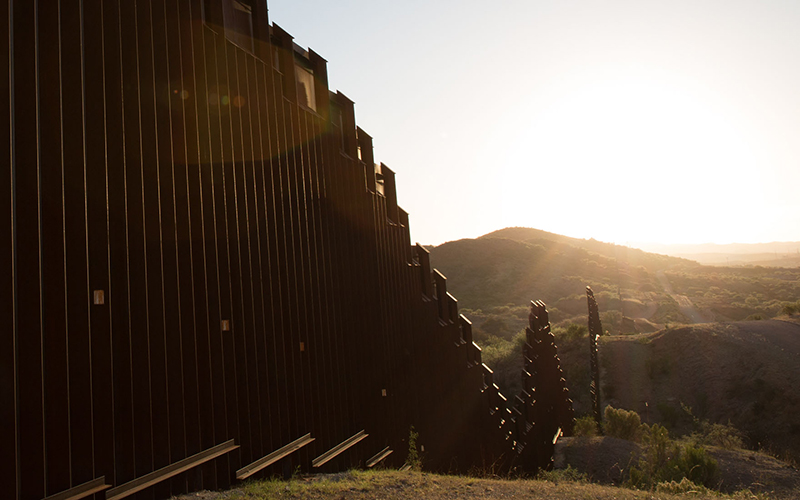WASHINGTON – The existing partial border wall with Mexico has caused environmental damage, harmed border communities and failed to make the country safer, and a complete border wall would only make things worse, according to a report released Wednesday.
The report, “Death, Damage, and Failure: Past, Present, and Future Impacts of Walls on the U.S.-Mexico Border,” called for a pause on the funding and construction of “additional border walls, and a re-evaluation of the strategy that led to them.”
“So long as impact of border walls are not examined and quantified, and so long as alternative solutions are not duly considered, the default approach will always be more walls and walls in ever more places,” said the report by the American Civil Liberties Union and a coalition of border and environmental groups.
But supporters of the wall disagreed with the notion that it would cause more harm and said it ignores what they called one of the biggest threats to the border environment – border crossers.
“If you want to shut off the flow of people who demonstrably do cause environmental degradation now, on a very large scale on a local level, the best thing you can do is erect a barrier and keep these people out,” said Bonner Cohen, a senior fellow at the National Center for Public Policy Research.
The report looked at the existing 654 miles of barriers on the U.S.-Mexico border and found numerous problems, not the least of which is that they have damaged “critical habitat for wildlife” in border states and displaced endangered species native to these areas.
Randy Serraglio, Southwest Conservation Advocate for the Center for Biological Diversity, said in a conference call to release the report that the borderlands are “a globally important biodiversity hotspot.” His center found that 93 threatened and endangered species would be harmed by a wall along the entire border, “including 2 million acres of designated critical habitat for endangered species that are protected by law in the United States.”
“When habitat is disrupted and destroyed, it affects species directly,” Serraglio said. “So the jaguar, ocelot, Mexican wolf, you know, these are the stars of this list, but there are many other species along the border that would be harmed by continuation of construction on this border wall.”
Cohen disagreed, saying he believes that animals are adaptable enough to survive being displaced by a border wall: “They’ll just move on to someplace else,” he said.
The report also said that border barriers have “disturbed or destroyed indigenous cultural sites” along the border, particularly those of the Tohono O’odham Nation, and that the walls have “led to the silting up or filling in of sensitive wetlands and waterways.”
It pointed to flooding in Organ Pipe National Monument, where Customs and Border Protection walls have grates that “quickly became clogged with debris” in a monsoon. Water behind some walls “rose to a depth of seven feet” before spilling over and causing millions of dollars in damage, the report says.
Another consequence of border walls is that they have led to a rise in deaths of border crossers, advocates say. The report attributed an increase in border-crossing deaths since 1995 to Border Patrol’s Prevention Through Deterrence, a strategy aimed at reducing unauthorized immigration by constructing walls and concentrating agents in certain areas.
“This only accomplished to funnel immigrants to the most dangerous places of the border, where thousands have died,” said Astrid Dominguez, director of the ACLU’s Border Rights Center.
Most of these deaths were a result of heat exposure, particularly in Arizona and California, the report said.
“More border walls means more border deaths,” said Scott Nicol, chair of the Sierra Club’s Borderlands team.
But Ira Mehlman, a spokesman for the Federation for American Immigration Reform, said the U.S. should not feel responsible for reducing the number of deaths that occur when migrants attempt to cross the border.
“People have to take responsibility for their own decisions, and the best way to prevent people from acting in ways that put their lives at risk is to make it clear to them that they’re not going to benefit from doing it,” said Mehlman, adding that starts with a wall and continues to domestic policy.
He agreed with Cohen that a wall would actually help the border. While there’s no perfect solution to enforcing the border, Mehlman said, constructing more walls is better than not doing so.
“You have an alternative here – construct the wall and cut down on human traffic, or continue the situation that has existed for a long time, which also results in severe environmental damage,” Mehlman said. “When you have hundreds of thousands of people traipsing across the wilderness, leaving tons of garbage in their wake, trampling on the flora, it has a profound impact.”
But the report said the evidence speaks otherwise, and points to a halt in wall construction.
“Ignoring on-the-ground realities has become a hallmark of United States border policy,” the report said. “As a result, the U.S. has turned away from addressing the complex causes of immigration and smuggling, and a careful consideration of the most effective ways to respond to these issues, and instead has focused myopically on enforcement and militarizing our borders.”
